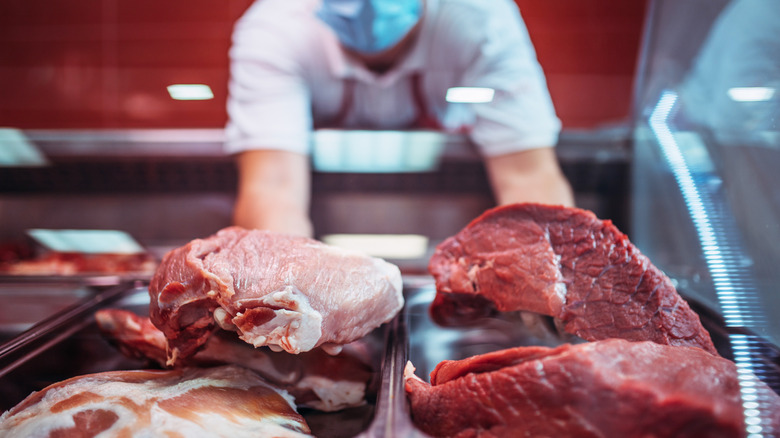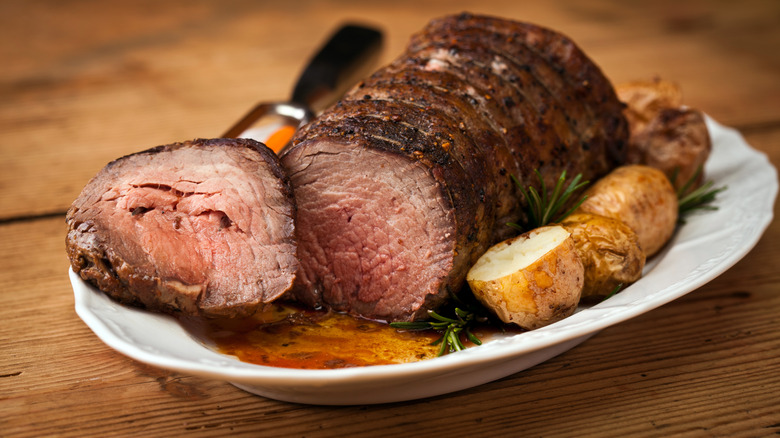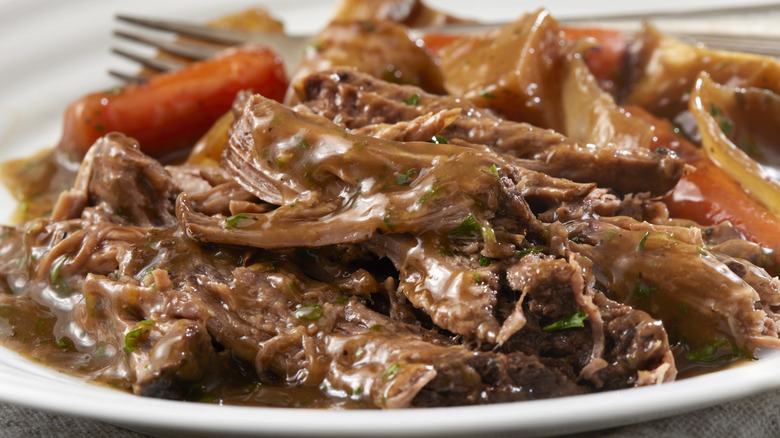The Cooking Methods That Differ Between Pot Roast And Roast Beef
Pot roast and roast beef; the names are so similar and the Venn diagram of these two distinct dishes does indeed have much overlap, but they shouldn't be confused for one another. Both are made from large cuts of beef and intended to feed a crowd, but the cuts themselves and the cooking method applied to each set them apart.
Confusion here stems from the liberal application of the term "roast" and its dual meaning. As a verb, to roast something is to cook it in the dry heat of an oven. In this sense, it applies to roast beef — although roasted beef might be a clearer name — as it is cooked at a somewhat high temperature in the oven and develops a burnished crust that belies the rare, tender meat within. But roast can also refer to a cut of meat. Pot roast is indeed a roast-style cut of beef, but not one you'd typically see used for roast beef, and not at all cooked the same way. Pot roast involves tough cuts rendered to fall-apart tenderness with the gentle application of moist heat over a long period of time.
These are only the top-level differences. A deeper dive reveals just how unique roast beef and pot roast are, what goes into each, and how they are traditionally served.
What is roast beef?
Do you view roast beef as a cold cut or a mealtime centerpiece? It can be both; satisfying as either a steaming cut of beef fresh from the oven aside mashed potatoes and a dash of horseradish cream, or as a sandwich with piled-high slices between thick pieces of hearty bread.
As we've discussed here before, there are scads of large cuts that make a great roast beef, but it's important to understand your desired end result before making a purchase. Some cuts, like shoulder petite roast, do best with a quick cooking time at a higher temperature that yields a red to pink interior with a fabulous crust. Those cuts with more fat, connective tissue, or both, such as bottom round roast, need to be coaxed into tenderness with a more gentle cooking regimen. Once you've matched the cut to the cooking method, you can begin to think about seasoning the meat. An herbaceous rub with plenty of salt, fresh-ground black pepper, and rosemary can contribute to the crust of the meat wonderfully. A strong marinade is also a winning option, particularly for the leaner cuts that lack the flavor contributed by fat.
Another important thing to keep in mind is how you slice the final product. Many of the cuts used for roast beef have long muscle fibers that run the course of the beef. For these, make note of the direction of this grain and cut on an opposing angle.
What is pot roast?
Pot roast is a true winter warmer that is meltingly tender and swimming in rich, unctuous, brothy cooking liquids that pairs perfectly with roasted vegetables, creamy mashed potatoes, and plenty of buttered rolls for sopping up the juice. Much like roast beef, there are several cuts of meat that can be used for pot roast, but the scope is a bit narrower. Traditionally pot roast is made from a tough cut of beef with plenty of intramuscular fat marbling and connective tissue, such as chuck roast or brisket. These cuts of meat need long cooking times at relatively-low heat in order for the fat to render and the connective tissue to melt.
This is typically achieved by first searing the meat in a deep, thick-walled pot to build flavor, then semi-submerging it in liquid like water or stock, though wine or beer may also be used for a different flavor profile. Aromatics like mirepoix, garlic, and herbs, such as rosemary, thyme, and bay leaves, can also be employed as the pot roast braises in the even heat of the oven. For those looking for an outside-the-box spin on pot roast, try tossing some pickles or ginger snaps into the pot.
While pot roast and roast beef shouldn't be confused for one another, they both offer great ways to make use of overlooked, affordable cuts of beef that can feed a crowd.


